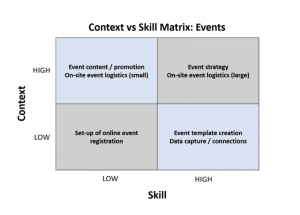As it’s becoming safe to return to corporate offices, many employers are offering workers the choice to fully return, remain fully remote, or “float” between these two work environments. A flexible work policy emphasizes employee choice and promotes a much-needed healthy work-life balance.
It also presents a significant challenge for team leaders who have to build a bridge that spans both worlds of work. How will you run a whiteboard brainstorm session when only half of your team members are physically present in the room? How can you regain pre-pandemic efficiencies if you remain fully virtual even after some team members return onsite? If you’re a hybrid team leader, there’s no such thing as business as usual.
Fortunately, a unique combination of timeless people management principles and innovative technology-powered capabilities will help you maximize the performance and experiences of your hybrid team members. Here are tips to build a bridge between your onsite and remote workers to ensure both groups are engaged and productive.
KNOWLEDGE IS POWER
As a hybrid team leader, you need to be able to distinguish between the individual needs and preferences of your team members. Remote workers, for example, may differ in terms of their need for live social interaction. Some will crave as much as they can get while others may bristle at the thought of one more “cameras on” minute.
- Ask about each worker’s preferred work format—including start/stop times—and try to synchronize team breaks where possible.
- Determine each onsite worker’s healthy workplace preferences and make an effort to accommodate requests regarding proximity and workstation arrangement.
- Utilize assessment tools to understand each person’s attitudes and traits that can influence their workplace behaviors and preferences.
- Raise group awareness of team members’ preferred working styles and needs in a way that maintains psychological safety for all.
- Establish a cadence of check-ins to ensure you can identify and respond to changes as the hybrid team gels and performs its work.
LEVEL THE PLAYING FIELD
One of the biggest challenges you’ll face as a hybrid team leader is a need to create equity among your team members. This includes facetime, access to information, and focused attention. You’ll need to take steps to capitalize on the advantages and overcome natural disadvantages inherent with each group.
- If you haven’t already, offer a stipend to remote workers so they can invest in technologies that will help them collaborate as effectively as possible.
- Run remote-friendly meetings—ensure quality audio (no eating potato chips near the conference phone) and provide links to collaboration documents and tools in advance.
- If you decorate your physical team space (e.g., tropical theme, movie posters), invite remote attendees to have input on office decorating decisions, and make it easy for them to adopt the theme in their remote workspaces.
- Be vigilant against bias between “in group” and “out group” members by ensuring that promotions, work assignments, and praise are meted out fairly among onsite and remote workers.
TRANSPARENCY = TRUST
Hybrid teams need to do their work in the broad light of day. This is where collaboration technologies can really come in handy. Creating maximum visibility ensures information parity and invites trust among disparate team members.
- Use collaboration tools like Google Workplace documents, Asana, Slack, and Miro to keep everyone on the same page.
- Greet remote meeting attendees, and remember to say goodbye to them before trundling off.
- When the meeting ends don’t continue it while walking to the next meeting; if you do continue the conversation, follow-up with notes that are shared with all original attendees.
- Encourage onsite meeting attendees to bring their laptops and use their video cameras whenever remote attendees are present.
As a team leader, you need to ensure the effectiveness and well-being of your team members whether they are onsite, remote, or somewhere in between. By understanding their personal preferences, ensuring equity, and creating transparency, you can lead them to collective success despite any physical distance that may stand between you.
Business & Finance Articles on Business 2 Community
(65)






